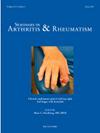The effectiveness and safety of rituximab in juvenile idiopathic arthritis: Hints from the ITHACA monocentric registry
IF 4.4
2区 医学
Q1 RHEUMATOLOGY
引用次数: 0
Abstract
B cells contribute to the pathogenesis of juvenile idiopathic arthritis (JIA), suggesting a therapeutic potential for B cell depleting agent rituximab (RTX).
This retrospective study describes the effectiveness and safety of RTX in a monocentric cohort of JIA patients. Disease activity was assessed using DAS28-CRP at baseline and at each RTX infusion.
Thirty-seven JIA patients (56.8 % with polyarticular JIA) received RTX between 2008 and 2023, at a median age of 23.5 years. Most patients had a refractory disease: 45.9 % of the cohort received >2 prior biologics. The median exposure time to RTX was 2.5 years, with a median number of 5 cycles per patient and a median follow-up from first infusion of 7.44 years. At 6 months, 73 % of patients responded to RTX, and 48.6 % achieved remission. At 12 months, the trend in reducing DAS28-CRP levels persisted. ACPA positivity improved remission rates although not significantly; in most cases, uveitis did not respond to RTX. Six patients (16.2 %) discontinued RTX thanks to a prolonged remission, none requiring further biologics at a follow-up of 1.4 years. Both hypogammaglobulinemia and clinically relevant infections occurred in 27 % of the cohort. Receiving >4 RTX cycles predicted the development of hypogammaglobulinemia and/or infections (sensitivity 71.9 %, specificity 60.0 %).
Although the optimal patient selection strategy remains unclear, RTX might be regarded as an effective treatment for refractory cases, particularly in oligo/polyarticular JIA, with a manageable safety profile when exposure is limited to 4 cycles.

利妥昔单抗治疗青少年特发性关节炎的有效性和安全性:来自ITHACA单中心注册的提示
B细胞参与了幼年特发性关节炎(JIA)的发病机制,提示B细胞消耗剂利妥昔单抗(RTX)具有治疗潜力。这项回顾性研究描述了RTX在JIA单中心队列患者中的有效性和安全性。在基线和每次RTX输注时使用DAS28-CRP评估疾病活动性。37例JIA患者(56.8%为多关节JIA)在2008年至2023年间接受了RTX治疗,中位年龄为23.5岁。大多数患者患有难治性疾病:45.9%的队列患者既往接受过2种生物制剂治疗。RTX的中位暴露时间为2.5年,每位患者的中位数为5个周期,从首次输注开始的中位随访时间为7.44年。在6个月时,73%的患者对RTX有反应,48.6%的患者获得缓解。在12个月时,降低DAS28-CRP水平的趋势持续存在。ACPA阳性改善缓解率,但不显著;在大多数情况下,葡萄膜炎对RTX没有反应。6名患者(16.2%)因缓解期延长而停用RTX,随访1.4年,无患者需要进一步使用生物制剂。低丙种球蛋白血症和临床相关感染发生在27%的队列中。接受4个RTX周期预测低丙种球蛋白血症和/或感染的发展(敏感性71.9%,特异性60.0%)。虽然最佳患者选择策略尚不清楚,但RTX可能被认为是难治性病例的有效治疗方法,特别是寡关节/多关节JIA,当暴露限制在4个周期时具有可控的安全性。
本文章由计算机程序翻译,如有差异,请以英文原文为准。
求助全文
约1分钟内获得全文
求助全文
来源期刊
CiteScore
9.20
自引率
4.00%
发文量
176
审稿时长
46 days
期刊介绍:
Seminars in Arthritis and Rheumatism provides access to the highest-quality clinical, therapeutic and translational research about arthritis, rheumatology and musculoskeletal disorders that affect the joints and connective tissue. Each bimonthly issue includes articles giving you the latest diagnostic criteria, consensus statements, systematic reviews and meta-analyses as well as clinical and translational research studies. Read this journal for the latest groundbreaking research and to gain insights from scientists and clinicians on the management and treatment of musculoskeletal and autoimmune rheumatologic diseases. The journal is of interest to rheumatologists, orthopedic surgeons, internal medicine physicians, immunologists and specialists in bone and mineral metabolism.

 求助内容:
求助内容: 应助结果提醒方式:
应助结果提醒方式:


